Σπηλαιο Των Λιμνων
Spilaio Ton Limnon - Lake Cave - Cave of Lakes
Σπιλαια Καστριων
Spilaia Kastrion - Cave of Kastria
Useful Information

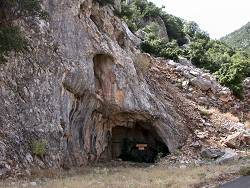
| Location: |
Kalavryta–Klitoria Rd, near Kastria, Achaia Prefecture.
17 km from Kalavrita, 49 km from Goritza, 69 km from Tripolis. (37.959582, 22.140053) |
| Open: |
All year daily 9-16:30. [2023] |
| Fee: |
Adults EUR 9, Children (6-16) EUR 4.50, Students EUR 4.50, Unemployed EUR 4.50, Seniors (65+) EUR 4.50. Groups (30+): Adults EUR 7. [2023] |
| Classification: |
 Karst Cave Karst Cave
 River Cave River Cave
 Rimstone Pool Rimstone Pool
|
| Light: |
 Incandescent Incandescent
|
| Dimension: | L=1,980 m, T=15 °C. |
| Guided tours: | L=780 m, D=45 min. |
| Photography: | allowed |
| Accessibility: | no |
| Bibliography: | |
| Address: |
Cave of the Lakes, Municipality of Kalavrita Achaia, Kalavryta–Klitoria Rd, Tel: +30-26920-31001.
E-mail: |
| As far as we know this information was accurate when it was published (see years in brackets), but may have changed since then. Please check rates and details directly with the companies in question if you need more recent info. |
|
History
| 1922 | after heavy rains a wild river left the cave at the natural entrance. |
| 1940 | after heavy rains a wild river left the cave at the natural entrance. |
| 1964 | some inhabitants of Kastria used a wooden ladder to climb the first step of the cave and discovered the first lake. |
| 1965 | explored by the palaeontologist Professor J. Melendis, Anna Petrocheilou, and the Greek Speleological Society. |
| 1967 | first archaeological excavation in the entrance section by Efthymios Mastrokostas. |
| 1971 | second archaeological excavation in the entrance section by Photios Petsas. |
| 1981 | development of the cave started by the Hellenic Tourism Organization (E.O.T.). |
| 1990 | first part opened to the public. |
| 1992-1994 | excavation by the Ephorate of Paleoanthropology-Speleology, headed by Adamantios Sampson, Professor of Prehistoric Archaeology at the University of the Aegean. |
| MAY-2001 | second part of show cave opened to the public. |
Description
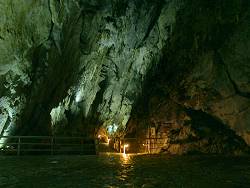
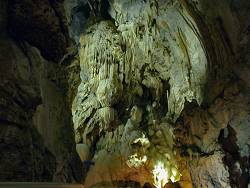
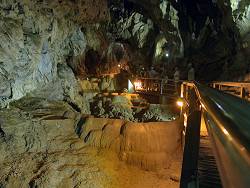
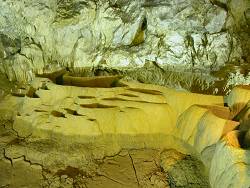
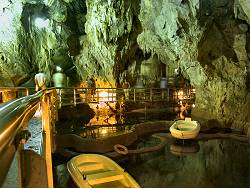
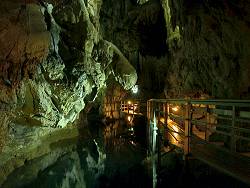
Spelaio Ton Limnon, the Cave of the Lakes, is the bed of a subterranean river, flowing only during the winter rains.
When the rain ends in spring, the river and the water dripping from the ceiling stops almost completely, but thirteen waterfilled pools remain over most of the summer.
The lakes are commonly called gours or
 rimstone pools.
They are a special sort of speleothems, forming huge but thin and curly dams.
Today it may be a few less than the thirteen pools mentioned above, as the lower ones became leaky during the development works.
Nevertheless, the development of this cave is extraordinary good.
It has been renewed only a few years ago and the paths are now very modern of concrete and stainless steel with minimal impact on the cave and its speleothems. The whole path has only very few steps at the end of the tour.
And the path is most of the time a bridge-like structure, which gives the visitor the feeling to walk above the cave.
rimstone pools.
They are a special sort of speleothems, forming huge but thin and curly dams.
Today it may be a few less than the thirteen pools mentioned above, as the lower ones became leaky during the development works.
Nevertheless, the development of this cave is extraordinary good.
It has been renewed only a few years ago and the paths are now very modern of concrete and stainless steel with minimal impact on the cave and its speleothems. The whole path has only very few steps at the end of the tour.
And the path is most of the time a bridge-like structure, which gives the visitor the feeling to walk above the cave.
The cave has three levels. The lowest level is the natural entrance, which can be seen at the road to Kastria right below the modern entrance. This cave is mostly dry, but after heavy rains in 1922 and 1940 a wild river left the cave at this place. The second level of the cave, is today’s show cave. The third level is not open to the public. And obviously there is another level, which is not explored until now, somewhere below. The river which formed the cave drained the highland Apanokampos. This river now flows below the known parts of the cave, still draining the highland and the water reappears in the springs of the river Aroanios, 8 km south of the cave.
Although the natural entrance was known to the locals for very long, it took until 1964, when some inhabitants of Kastria used a wooden ladder to climb the first step of the lower cave and discovered the first lake in the higher level. In 1965 the new cave was explored by the Hellenic Alpine Club, lead by the palaeontologist Professor J. Melendis and the Hellenic Speleological Society, lead by Anna Petrocheilou. In the entrance area, Professor Melendis found bones of a hippopotamus (300,000 years old), deer (100,000 years old) and man of much more recent date but in poor condition. The finds are on display at the Paleontologic Museum at Athens.
Zoologist Professor J. Ontrias found four different species of bat living in the cave. Later Professor Ioanna Iliopoulou from Patras University found a fifth species.
In 1967 the first archaeological excavation was made in the entrance section by Efthymios Mastrokostas. The next excavation in 1971 was made by Photios Petsas. An excavation by the Ephorate of Paleoanthropology-Speleology, headed by Adamantios Sampson, Professor of Prehistoric Archaeology at the University of the Aegean, was carried out between 1992 and 1994. The oldest human remains of the cave are from the Late Neolithic Ib-II, some 6,000 years BP. The cave was again visited during the Late Bronze Age (~3100 BP), the Early Helladic and Late Middle Helladic periods. A cave which was mentioned in a Greek legend is thought to be this cave.
Melampous was the first human who received the power of healing and the power to see the future from the gods. He lived in this cave.
King Proitos of Tiryns had three beautiful daughters. They were named Lissippi, Iphinoe and Iphianassa. One day, they boasted that they were more beautiful than Goddess Hera and laughed about the Dionysos cult. Hera was so angry, she gave them a sickness of the brain.
The three girls were muddleheaded and thought they were cows. Roaring like cows they ran through the Argolis and the women they met were infected with the insanity and killed their own children. Iphinoe died on the way. At last, the two others came to the cave of Melampous, who healed them and brought them to the next village called Loussi.
This story is told by Pausanias (*111/115-✝180), Greek writer, in his book Description of Greece, chapter Arkadia.
The show cave of today starts behind the 9 m ascent from the lower level. As Anna Petrocheilou suggested, a tunnel was built and the cave is now entered at the Bat Hall, 20 m above the natural entrance. This is the biggest chamber of the tour, 40 m long, 15 m wide and 30 m high. The name is easy to understand: at the ceiling is a big bat colony. A part of the first platform is a bit slippery by the bat guano and the typical smell of the bats is in the air.
The cave is a horizontal cave, more or less a single main passage, up to 15 m wide and up to 30 m high, most of the time it is about 8 m wide and 15 m high. The path, starting as a regular path of concrete slabs, soon rises above the ground and stands on pillars. So all rimstone pools are still untouched by the tourist path.
The first section shows several beautiful speleothems, but they are of a rather common type: stalactites, stalagmites, curtains, and draperies. But then the path raises a bit and the first rimstone pools appear, dry during the summer, this first pools allow a close look at their structure. And the last part shows several water-filled pools, typically about 40 m long, 10 m wide and 5 m deep. This part also shows some pools with nice calcite crystals.
At the end of the path, the tour turns around and the visitors have to walk back the same path. Together with the artificial entrance tunnel the tour is 780 m long, as the tours return the same way it’s a 1,560 m walk. The cave was first opened as a show cave in 1990 with a length of 500 m, later the tour was extended in 2001. The famous speleothems with aragonite crystals and dogtooth spars are not shown during the tour. The administration plans to extend the tourist part once more to include them, but so far it not clear when. However, since they have been planning an extension for 20 years to no avail, it seems unlikely that this will happen in the near future.
The entrance building of the cave contains a small museum. It contains numerous archseological remains which were discovered in the cave. There are human and animal bones, pottery, and tools made of obsidian and flint.
- See also
 Search DuckDuckGo for "Ton Limnon Cave"
Search DuckDuckGo for "Ton Limnon Cave" Google Earth Placemark
Google Earth Placemark Cave of the Lake - Wikipedia (visited: 19-FEB-2023)
Cave of the Lake - Wikipedia (visited: 19-FEB-2023) Cave of Kastria, official site. (
Cave of Kastria, official site. (
 )
) Cave of the Lakes (visited: 19-FEB-2023)
Cave of the Lakes (visited: 19-FEB-2023) Cave of the Lakes (visited: 19-FEB-2023)
Cave of the Lakes (visited: 19-FEB-2023) Cave of the Lakes at Kastria - Kalavryta (visited: 19-FEB-2023)
Cave of the Lakes at Kastria - Kalavryta (visited: 19-FEB-2023)
 Index
Index Topics
Topics Hierarchical
Hierarchical Countries
Countries Maps
Maps